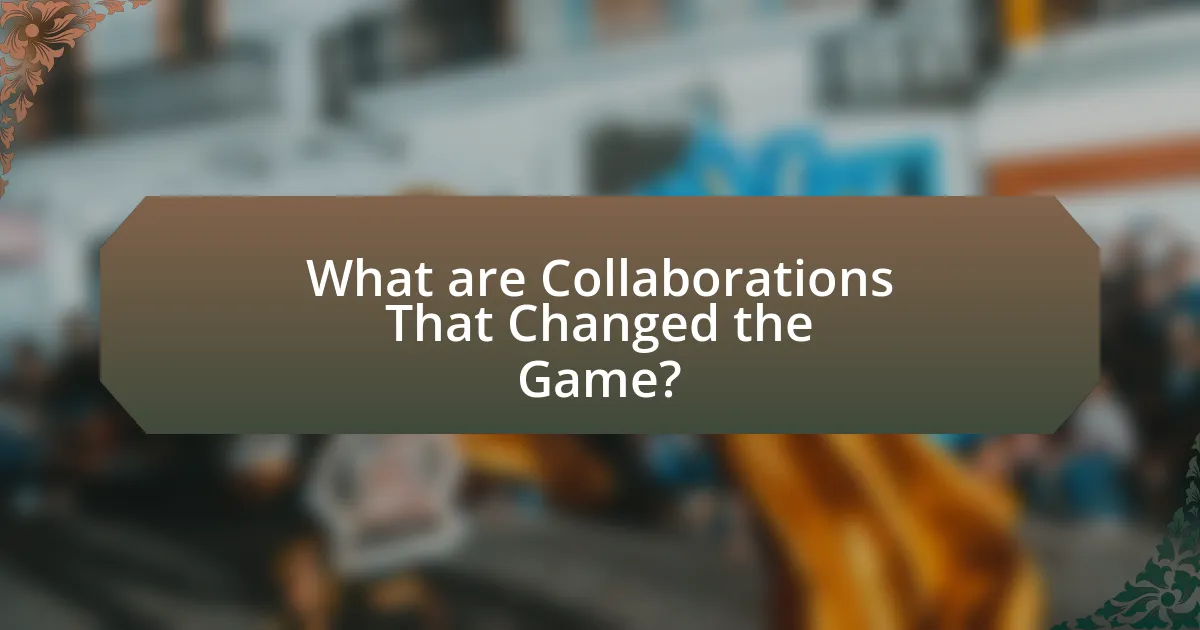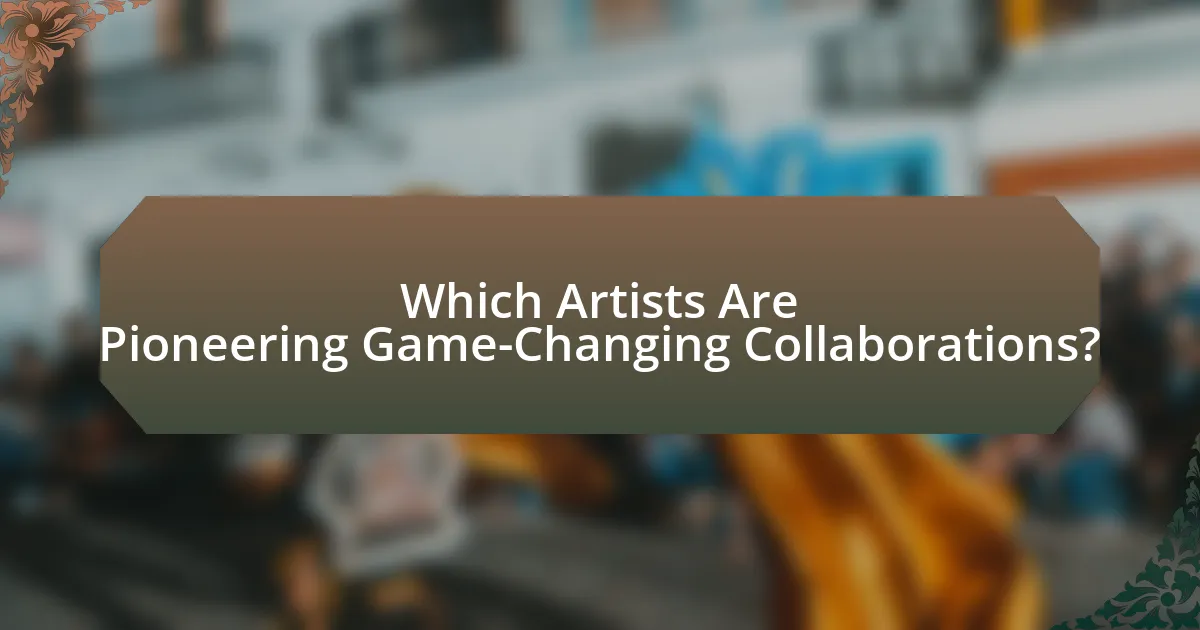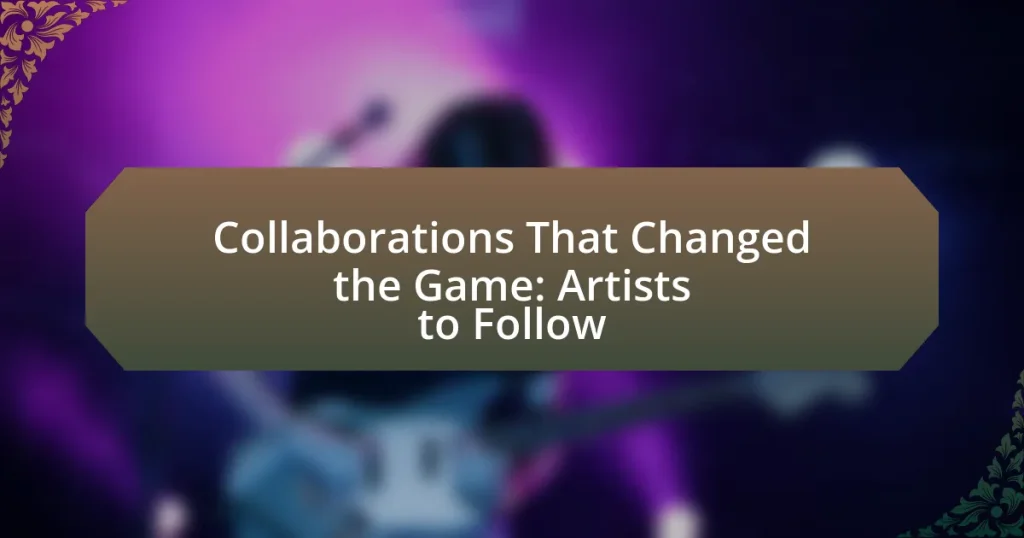Collaborations that changed the game have significantly impacted various industries, particularly in fashion, music, and entertainment. Notable partnerships include Nike and Off-White, which transformed sneaker culture, and Jay-Z and Linkin Park, whose album “Collision Course” blended hip-hop and rock. The article explores how collaborations influence the music industry by fostering genre-blending and expanding audience reach, highlighting landmark projects that reshaped genres. It also examines the qualities that make artists stand out in collaborative efforts, the benefits of exploring collaborative music, and recent collaborations that have garnered attention, providing insights into the dynamics and significance of these partnerships.

What are Collaborations That Changed the Game?
Collaborations that changed the game include the partnership between Nike and Off-White, which revolutionized sneaker culture by blending high fashion with streetwear, resulting in the highly sought-after “The Ten” collection. This collaboration not only elevated the status of sneakers as fashion statements but also increased resale values, with some pairs selling for thousands of dollars. Another significant collaboration is between Jay-Z and Linkin Park, which produced the album “Collision Course,” merging hip-hop and rock genres and introducing a new audience to both styles. This project achieved multi-platinum status and showcased the potential of genre-blending in music. Additionally, the collaboration between Marvel and Netflix led to a series of critically acclaimed shows like “Daredevil” and “Jessica Jones,” which expanded the superhero genre on television and attracted a diverse viewership, ultimately influencing the direction of streaming content. These collaborations exemplify how strategic partnerships can redefine industries and create lasting impacts.
How have collaborations influenced the music industry?
Collaborations have significantly influenced the music industry by fostering genre-blending and expanding audience reach. For instance, the collaboration between Run-D.M.C. and Aerosmith on “Walk This Way” in 1986 merged hip-hop and rock, leading to a broader acceptance of rap music in mainstream culture. This partnership not only revitalized Aerosmith’s career but also introduced hip-hop to a wider audience, demonstrating how collaborations can create new musical landscapes and drive commercial success. Additionally, data from the Recording Industry Association of America shows that collaborative tracks often achieve higher chart positions, indicating their impact on listener engagement and sales.
What are some landmark collaborations that reshaped genres?
Some landmark collaborations that reshaped genres include the partnership between Run-D.M.C. and Aerosmith on “Walk This Way,” which fused hip-hop and rock, significantly impacting both genres. Another pivotal collaboration is the work of David Bowie and Queen on “Under Pressure,” which blended rock and pop elements, influencing countless artists. Additionally, the collaboration between Daft Punk and Pharrell Williams on “Get Lucky” revitalized disco and electronic music, showcasing the power of cross-genre partnerships. These collaborations not only created iconic tracks but also set new standards for genre blending in the music industry.
How do collaborations enhance artistic expression?
Collaborations enhance artistic expression by combining diverse perspectives, skills, and techniques, leading to innovative and unique creations. When artists from different backgrounds collaborate, they merge their individual styles and ideas, resulting in works that reflect a broader range of influences and emotions. For instance, the collaboration between musicians and visual artists often produces multimedia experiences that engage audiences in new ways, as seen in projects like the partnership between David Bowie and artist Brian Eno, which revolutionized music production and performance art in the late 20th century. This blending of talents not only fosters creativity but also challenges traditional boundaries within art forms, encouraging experimentation and pushing the limits of what art can be.
Why should we follow artists known for impactful collaborations?
Following artists known for impactful collaborations is essential because these partnerships often lead to innovative and genre-defining work. Collaborations can combine diverse influences, resulting in unique artistic expressions that push boundaries and challenge conventional norms. For instance, the collaboration between David Bowie and Queen on “Under Pressure” not only created a timeless hit but also showcased the fusion of rock and pop elements, influencing countless artists thereafter. Such collaborations frequently generate significant cultural conversations and can elevate the visibility of all artists involved, as seen in the success of the “Watch the Throne” album by Jay-Z and Kanye West, which broke sales records and reshaped hip-hop. Therefore, engaging with these artists allows followers to experience cutting-edge creativity and understand the evolving landscape of music and art.
What qualities make these artists stand out?
These artists stand out due to their innovative creativity, unique styles, and impactful collaborations. Their ability to blend different genres and influences results in fresh, engaging music that resonates with diverse audiences. For instance, artists like Billie Eilish and Finneas O’Connell have redefined pop music through their experimental soundscapes and intimate songwriting, which have garnered multiple Grammy Awards, showcasing their influence and recognition in the industry. Additionally, their willingness to collaborate with a variety of artists across genres enhances their versatility and broadens their appeal, making them significant figures in contemporary music.
How do their collaborations reflect their artistic vision?
Their collaborations reflect their artistic vision by merging diverse styles and perspectives, which enhances their creative output. For instance, when artists from different genres collaborate, they often create innovative works that challenge traditional boundaries, showcasing their willingness to experiment and evolve. A notable example is the partnership between musicians and visual artists, which often results in multimedia projects that blend sound and imagery, illustrating a holistic approach to art. This synergy not only broadens their audience but also reinforces their commitment to pushing artistic limits, as seen in collaborative albums that incorporate various influences and techniques, ultimately enriching their individual artistic narratives.

Which Artists Are Pioneering Game-Changing Collaborations?
Artists pioneering game-changing collaborations include Billie Eilish and Finneas O’Connell, who have redefined pop music through their unique songwriting partnership. Their work on Eilish’s debut album “When We All Fall Asleep, Where Do We Go?” not only achieved commercial success, topping charts globally, but also won multiple Grammy Awards, showcasing their innovative approach to music production and collaboration. Another notable example is Travis Scott, who has successfully blended genres and collaborated with brands like McDonald’s, creating a cultural phenomenon that merges music and marketing. These collaborations illustrate how artists are reshaping the landscape of music and brand partnerships, influencing trends and audience engagement.
Who are the top artists to watch in collaborative projects?
The top artists to watch in collaborative projects include Billie Eilish, who has gained acclaim for her partnerships with artists like Khalid and Justin Bieber, showcasing her versatility and appeal across genres. Another notable artist is Anderson .Paak, recognized for his collaborations with Bruno Mars in the duo Silk Sonic, which has received critical and commercial success. Additionally, Dua Lipa stands out for her impactful collaborations with artists such as Elton John and DaBaby, further solidifying her presence in the music industry. These artists exemplify the power of collaboration in creating innovative and popular music.
What recent collaborations have garnered significant attention?
Recent collaborations that have garnered significant attention include the partnership between Beyoncé and Kendrick Lamar on the song “Nile” for the soundtrack of Disney’s “The Lion King: The Gift.” This collaboration has been widely praised for its cultural impact and musical innovation. Additionally, the collaboration between Travis Scott and McDonald’s, which featured a limited-edition meal and merchandise, generated substantial media coverage and consumer interest, highlighting the intersection of music and fast food branding. These collaborations exemplify how artists are leveraging partnerships to enhance their visibility and influence in various industries.
How do these artists select their collaboration partners?
Artists select their collaboration partners based on shared artistic vision, complementary skills, and mutual respect. They often seek individuals whose work aligns with their own style or message, ensuring that the collaboration enhances both parties’ creative output. For instance, successful collaborations frequently arise from artists who have previously expressed admiration for each other’s work or have collaborated in the past, as seen in partnerships like Jay-Z and Kanye West, where their combined strengths in hip-hop led to critically acclaimed projects. This strategic selection process is crucial for achieving a cohesive and impactful final product.
What genres are most influenced by collaborative efforts?
The genres most influenced by collaborative efforts are hip-hop, electronic dance music (EDM), and rock. In hip-hop, collaborations between artists often lead to innovative sounds and broadened audiences, exemplified by tracks like “Sicko Mode” by Travis Scott featuring multiple artists. In EDM, collaborations are essential for creating diverse tracks, as seen in the success of projects like “Where Are Ü Now” by Skrillex and Diplo featuring Justin Bieber. Rock has also seen significant collaboration, with supergroups like the Traveling Wilburys showcasing how artists from different backgrounds can create impactful music together. These genres demonstrate that collaborative efforts can lead to groundbreaking developments and expanded creative possibilities.
How do collaborations differ across various music genres?
Collaborations differ across various music genres primarily in their structure, purpose, and cultural significance. In pop music, collaborations often aim for commercial success and broad audience appeal, exemplified by tracks like “Shallow” by Lady Gaga and Bradley Cooper, which topped charts globally. In contrast, hip-hop collaborations frequently emphasize lyrical prowess and authenticity, as seen in “Sicko Mode” by Travis Scott featuring Drake, where the interplay of verses showcases individual artistry while contributing to a collective narrative.
Moreover, in genres like country, collaborations often reflect storytelling and emotional connection, as demonstrated by “It’s Your Love” by Tim McGraw and Faith Hill, which highlights personal relationships. Electronic music collaborations tend to focus on production techniques and sound experimentation, with artists like Calvin Harris frequently collaborating with vocalists to create chart-topping dance tracks.
These differences illustrate how collaborations are tailored to the unique characteristics and audience expectations of each genre, influencing the creative process and the final output.
What are some genre-defining collaborations in recent years?
Some genre-defining collaborations in recent years include “Sicko Mode” by Travis Scott featuring Drake, which blends hip-hop and trap elements, and “Old Town Road” by Lil Nas X featuring Billy Ray Cyrus, which merges country and rap, creating a new genre crossover. These collaborations have significantly impacted music charts, with “Old Town Road” breaking the record for the longest-running number one on the Billboard Hot 100 at 19 weeks. Additionally, “Rain On Me” by Lady Gaga and Ariana Grande showcases a blend of pop and dance music, further influencing contemporary pop trends.

How Can Collaborations Enhance Your Music Experience?
Collaborations can enhance your music experience by introducing diverse sounds and perspectives, which enriches the overall listening experience. When artists from different genres or backgrounds come together, they create unique blends that can lead to innovative musical styles. For instance, the collaboration between Run-D.M.C. and Aerosmith on “Walk This Way” in 1986 fused hip-hop and rock, resulting in a groundbreaking hit that expanded the audience for both genres. This type of collaboration not only broadens the artistic palette but also fosters cross-genre appreciation among listeners, making music more accessible and enjoyable.
What are the benefits of exploring collaborative music?
Exploring collaborative music enhances creativity, broadens musical perspectives, and fosters community among artists. Collaborative efforts often lead to innovative soundscapes, as artists combine their unique styles and influences, resulting in fresh and diverse musical expressions. For instance, the collaboration between David Bowie and Brian Eno in the late 1970s produced the groundbreaking “Berlin Trilogy,” which significantly influenced the music landscape. Additionally, collaborations can expand an artist’s audience by introducing them to each other’s fan bases, as seen in the partnership between Jay-Z and Linkin Park, which merged hip-hop and rock, reaching a wider demographic. Overall, the benefits of collaborative music include increased creativity, audience expansion, and the creation of unique musical experiences.
How do collaborations introduce listeners to new sounds?
Collaborations introduce listeners to new sounds by merging distinct musical styles and influences from different artists. This blending creates innovative genres and unique sonic experiences that listeners may not encounter in solo works. For instance, the collaboration between David Bowie and Queen on “Under Pressure” combined rock and pop elements, resulting in a sound that was groundbreaking at the time. Such partnerships often lead to the exploration of diverse cultural influences, as seen in the work of artists like Shakira and Wyclef Jean, who fused Latin and hip-hop sounds, expanding their audience’s musical horizons.
What role do collaborations play in artist discovery?
Collaborations significantly enhance artist discovery by expanding their audience reach and increasing visibility. When artists collaborate, they tap into each other’s fan bases, which can lead to new listeners and followers. For instance, the collaboration between Billie Eilish and Khalid on the song “Lovely” introduced both artists to wider audiences, resulting in millions of streams and increased popularity for both. This phenomenon is supported by data showing that collaborative tracks often achieve higher chart positions and streaming numbers compared to solo releases, demonstrating the effectiveness of partnerships in artist promotion and discovery.
What tips can help you appreciate collaborative works?
To appreciate collaborative works, actively engage with the contributions of each participant. Understanding the unique skills and perspectives that each artist brings enhances the overall experience. For instance, analyzing how different styles blend in a collaborative piece can reveal deeper meanings and artistic intentions. Research shows that collaboration often leads to innovative outcomes, as seen in projects like the “The Beatles” where diverse influences created groundbreaking music. Recognizing these dynamics fosters a greater appreciation for the complexity and richness of collaborative efforts.
How can you analyze the dynamics of a collaboration?
To analyze the dynamics of a collaboration, one must assess the roles, interactions, and contributions of each participant. This involves examining communication patterns, decision-making processes, and the overall synergy between collaborators. Research indicates that effective collaboration often hinges on clear goals and mutual respect, which can be measured through surveys or observational studies. For instance, a study by Salas et al. (2015) in the “Journal of Applied Psychology” highlights that teams with defined roles and open communication channels achieve higher performance outcomes, demonstrating the importance of these dynamics in successful collaborations.
What should you listen for in collaborative tracks?
In collaborative tracks, you should listen for the interplay of distinct artistic styles and how they complement each other. This dynamic often results in unique soundscapes that showcase the strengths of each artist involved. For example, when artists from different genres collaborate, such as a hip-hop artist working with a classical musician, the fusion can create innovative rhythms and melodies that push creative boundaries. Additionally, pay attention to the lyrical content and how it reflects the perspectives of the collaborating artists, as this can provide deeper insights into their individual artistry and the themes they explore together.
